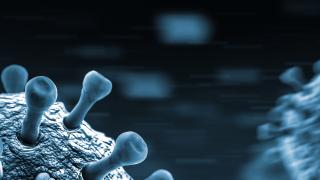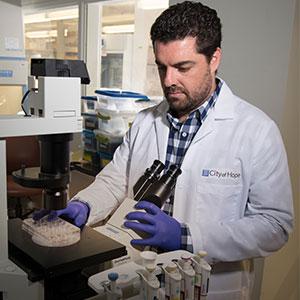At the moment, there is no vaccine and no medication that has been proven to target COVID-19. All we have right now is the body’s own frontline defense against enemy invaders — our immune system.
But what exactly is the immune system, how does it fight off foreign invaders, and what happens when it’s attacked by an enemy it never encountered before, like the COVID-19 virus?
To answer these questions and more, we sought out immunology expert Saul Priceman, Ph.D., assistant professor, Department of Hematology & Hematopoietic Cell Transplantation, and associate director of translational sciences in the T Cell Therapeutics Research Program at City of Hope.
Priceman’s laboratory focuses on developing cell-based immunotherapies, including advanced techniques like CAR T cell therapy, that boost patients' own immune systems to target their cancers. He is working with solid tumors in prostate, breast, ovarian and pancreatic cancers, which in advanced stages are in desperate need of effective treatment strategies. City of Hope has been heavily involved in this type of approach, and the therapeutic responses in many cases have been extraordinary. Priceman is now working on some of the most difficult cancer types to treat, and he is in early clinical trials at City of Hope testing these therapies in patients.
Like many of the staff at City of Hope, he’s ensuring the safety of the people in his laboratory, as well as the patients and essential employees on campus, by working from home, which is where we reached him for our Q&A session.
I know the immune system is incredibly complex — but can you give us a basic idea of how it works?
Its essential function is to protect us from things that could harm us — not just little things like viruses or bacteria, but other types of invaders, like parasites, fungi and even cancer. It’s a complex system — an organ made up of several subsystems, with functions and processes that we understand very well and some that we are still uncovering.
It might help to see the immune system as an army, with bases located in the lymphoid system, including the spleen, lymph nodes and bone marrow, and the immune cells traffic through the blood and lymphatic system to arrive at the front lines. Then there are the “soldiers” of the system, like T cells and B cells, which all have different jobs to do — recon, attack, communications and so forth.
So when an “enemy” invades the body, how does this system spring into action?
The bone marrow produces white blood cells called leukocytes, and they’re always out there patrolling your body in search of foreign invaders, or pathogens, which produce a kind of ID tag called an antigen.
One part of the system, the adaptive arm, actually has a memory response that records and remembers the invaders it’s encountered. So if the immune system finds an antigen it’s seen before, it can recall the memory responses and signal soldiers — fighting forces made up of T cells, B cells and other cell subsets — to launch their attack.
The B cells secrete the right antibody to bind to that particular antigen. Then the T cells come in for the kill, and cells called phagocytes help finish the job and clean away the dead cells.
The bad guys are defeated, health is restored — and the same process will protect you any time that same pathogen tries to attack.
A good example of that process is chickenpox virus. When you were a kid (if you’re older than a teenager now and didn’t get the varicella vaccine), you got infected and had blotches all over your body for two or so weeks. And then magically they went away, and you never got chickenpox again. Sure there’s shingles, and that’s a different discussion. But for the most part, you were protected by the soldiers of your immune system from that moment on, generating a memory response to the chickenpox virus for the rest of your life.
You said that occurs when the immune system recognizes the invader — but COVID-19 is a novel virus that our bodies haven’t seen before. What happens then?
When any pathogen attacks the body — even before the adaptive arm is mobilized — something called the innate arm is activated.
When the innate arm sees an antigen it’s never encountered before, there are no antibodies for it, so certain substances, including interferon, interleukin and cytokines, are released. They fight the pathogen with inflammation and fever, increasing blood flow to the infected areas. Natural killer cells, or NK cells, are also released, and they attach to an infected cell and try to kill it.
This is how the innate arm tries to keep the infection under control until the adaptive arm’s B cells produce the right antibodies to target virally infected cells, marking them for death, and T cells directly kill the virally infected cells.
To cure COVID-19, the two-phase immune response can take several weeks — as long as it would take for, say, a new strain of flu. This can be dangerous because before the right long-term response can be produced, the damage the virus can do, especially to certain organs like the lungs, may be extremely severe, which is why some patients need a respirator to breathe.
If your immune system has been compromised by an underlying condition, or if it has been weakened by aging or even from the battle with COVID-19 itself, the virus can win out and, unfortunately, result in severe damage to the body and even death.
What’s more, with COVID-19 and other extremely severe infections, the actions of the innate arm itself can produce a dire effect — a cytokine storm, in which the intense and prolonged inflammation meant to kill the virus might be more than the patient can endure. To continue the war analogy, this is akin to an indiscriminate bombing attack that destroys towns (in this case, healthy cells and tissue) as well as military targets (the virus).
With most viral infections, including other types of coronavirus, once the adaptive arm of the immune system has matured and the patient has recovered, long-lasting immunity usually results. There are indications this might also be true for COVID-19, but we are not yet certain.
Can you talk a little about how the immune system helps scientists develop treatments and vaccines for COVID-19?
Well, vaccines generally use a weakened or dead version of the virus to “train” a person’s immune system to respond if the actual virus does infect the body. As a result of that process, when the vaccinated person is exposed to the virus, the adaptive arm of their immune system remembers how to fight it.
We’re all eager for a vaccine — but it can’t happen overnight. First, we have to prove it’s safe, and then we have to show that it’s effective. The good news is that, when it comes to COVID-19, we may have a bit of a head start because scientists have been working — though not yet successfully — on vaccines for similar coronaviruses like SARS and MERS.
There’s also an interesting treatment for COVID-19 involving antibodies, which is currently being tested. Recently, the Food and Drug Administration gave emergency approval to an experimental approach that involves transfusing the plasma of convalescing patients, containing COVID-19 antibodies, into actively ill patients. This treatment has had some positive results with other coronaviruses, but there are not yet any definitive results for this and other approaches being tested during this critical time.
Some medications that have been FDA-approved for other conditions, such as tocilizumab and hydrochloroquine, are also being tested in clinical trials to determine whether they can dampen the severity of cytokine storm and other side effects of COVID-19.
Right now, the best way to protect yourself — in addition to all the other protective techniques we’re all quite familiar with right now such as social distancing, masks, gloves, disinfectants, hand-washing and so forth — is to keep your immune system strong. So eat nutritiously, get plenty of sleep and avoid stress as much as possible in these stressful times. Be safe everyone!

